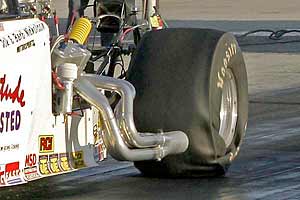|
GEARING FOR GO
The Right Way
To Choose A Gear Ratio Combination
By Wayne
Scraba
8/9/04
 Photo by Dale
Bryant
Photo by Dale
Bryant |
 pin
the clock back a few decades. In the days before
on-board computers and electronic fuel injection,
it was pretty easy to select a gear set for
your racecar. The selection process was dirt
simple: You just used what the local hot dog
ran (which invariably was a 4.56:1 or deeper
ring and pinion -- if you had 5.13's or 5.38's
out back, you were approached with some sort
of reverence). Bigger numbers and consequently,
lower gears were king. If you were sophisticated,
then the only real concern was the rpm at which
the car crossed the finish stripe on the drag
strip. pin
the clock back a few decades. In the days before
on-board computers and electronic fuel injection,
it was pretty easy to select a gear set for
your racecar. The selection process was dirt
simple: You just used what the local hot dog
ran (which invariably was a 4.56:1 or deeper
ring and pinion -- if you had 5.13's or 5.38's
out back, you were approached with some sort
of reverence). Bigger numbers and consequently,
lower gears were king. If you were sophisticated,
then the only real concern was the rpm at which
the car crossed the finish stripe on the drag
strip.
Fast forward: Today things are much more evolved,
and so is drag racing. Hardware that influences
the gearing in your racecar is much more predictable.
For the most part, you know how much a certain
slick grows. You can find out how much a torque
converter slips. Tachometers are ultimately
reliable and in many cases, they can "recall"
what the maximum engine speed was during a lap
down the 1320. And in many cases, you don't
even need to rely upon a tach or your faded
memory to know what the engine rpm was when
the car crossed the finish line: The on-board
computer will heartlessly inform you of the
peak rpm. In simple terms, no fudging is allowed.
It has probably been said dozens or even hundreds
of times over the years but it still holds true:
"Far too many racecars are over-geared."
It was something I examined years ago. One part
of the puzzle that has not been suitably addressed
completely is the actual mechanics of selecting
the appropriate rear axle ratio for your racecar.
The real key to gear ratio selection is to
simply take all of the variables into consideration.
Those variables can include the engine power
band, the transmission gear ratios (and indirectly,
the torque converter stall speed if the car
has an automatic transmission), the rear axle
or final drive ratio and the diameter of the
drive tires. In the words that follow (and I’ll
warn you, there are no photos), I'll take several
hypothetical real car combinations and examine
the variables. Additionally, we’ll look
at how these variables intertwine and how you
can use a calculator to work out the correct
gear ratios for your personal racecar.
When you take a close look at the rear rubber
used on the majority of today's drag cars, you'll
find that it's usually 32.0-inches or larger.
According to Marv Ripes at A-1 Automatic Transmissions,
slicks typically grow three percent for every
100 mph. Ripes also notes that some Super Stock
converter combinations can exhibit as much as
seven percent slippage while other converter
combos (particularly those used in SS/Modified
and Comp Eliminator cars) can have as little
as 4-4-1/2 percent slippage. It's easy to see
that in some cases, tire growth can almost completely
cancel out converter slippage. Keep in mind
too that the engine must have enough grunt to
push the vehicle to the top speed figure in
the first place (as you can see, the formulas
that follow do not take power or torque into
consideration). The purpose of the mathematical
examples is to show just how the numbers are
crunched.
When it comes to picking the right axle ratio
for your racecar, the real place to begin is
the engine combination. For this comparison,
I decided to include a trio of vintage big block
combinations. The basic combination is an off-the-wall
affair: It's a LS6 1970 El Camino. Although
it's in the official NHRA Stock Car Classification
Guide, I've never personally seen one in Stock
or Super Stock trim (for that matter, neither
have any number of tech gurus I've spoken with).
Perhaps the reason they aren't popular is the
fact that it could become difficult (if not
impossible) to hook consistently, particularly
with some real steam under the hood. None-the-less,
two engine combinations were used: one for a
Stocker and one for a Super Stocker. What we're
searching for is the maximum horsepower at a
given rpm level from the engine(s). What follows
are some hypothetical numbers (and please remember,
these are definitely hypothetical):
| Horsepower
Peaks |
| Stock
Eliminator LS6: 596 at 6250 rpm |
| Super
Stock Eliminator LS6: 694 at 6700 rpm |
As you can see, we have two very different
power peaks. Because of this, it shouldn't take
a rocket scientist to figure out that each of
these engines might "like" a different
transmission and rear axle ratio combination.
The bottom line is simple: You should select
the drive line combination to fit the power
and rpm characteristics of the power plant.
Otherwise you (and your engine) won't be terribly
happy.

|